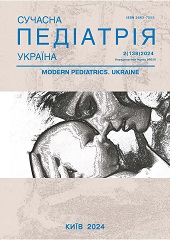Assessment of anthropometric measurements of premature children with physical developmental delays at preschool age
DOI:
https://doi.org/10.15574/SP.2024.138.80Keywords:
premature child, low birth weight for gestational age, physical developmental delay, anthropometric measurements, preschool ageAbstract
Assessment of child growth and development is crucial for paediatricians, as delays in these areas have significant socio-economic implications and their treatment can be costly.
Aim. To evaluate the anthropometric measurements of premature children with physical developmental delay at preschool age.
Materials and methods. The retrospective and prospective studies were conducted. A total of 108 children participated in the study. The children were classified into three groups: the main group, the comparison group, and the control group. The average age of children in the main group was 3.9±0.20 years, in the comparison group it was 4.2±0.19 years, and in the control group - 4.1±0.15 years. The main group (group I, n=57) was further divided into two subgroups: subgroup IA comprised 45 children born with a body weight appropriate for gestational age, subgroup IB consisted of 12 children with low body weight for gestational age (LBWGA). The comparison group (group II; n=31) was also divided into two subgroups: subgroup IIA included 26 children born with a normal body weight for their gestational age, subgroup IIB consisted of five children born with a low body weight for their gestational age. The control group comprised 20 premature infants born at 29-36 weeks of gestation with relatively satisfactory antenatal and intrapartum periods and no physical developmental delays. Physical development was evaluated based on anthropometry measurements, including height and body weight.
Results. The study included 57% male and 43% female children. Among the children with physical developmental delay, 37% were from the first gestation, 44.3% from the second gestation, and 18.7% from the third gestation. When analysing the data, a significant difference was found in height (p=0.0002) and body weight (p=0.0006). In the main group, children born with low body weight for gestational age showed more pronounced growth retardation, while in the comparison group, premature children differed from full-term ones with more significant growth retardation.
Conclusions. The study revealed that children born with low birth weight for gestational age have differences in body weight and height compared to children with appropriate weight for gestational age.
The study was conducted in accordance with the principles of the Declaration of Helsinki. The study protocol was approved by the Local Ethics Committee the aforementioned institution. Informed consent for the study was obtained from the parents of the children.
The authors declare no conflict of interest.
References
Albertsson-Wikland K, Karlberg J. (1997). Postnatal growth of children born small for gestational age. Acta Paediatr. Suppl. 423: 193-195. https://doi.org/10.1111/j.1651-2227.1997.tb18413.x; PMid:9401571
Andersson NW, Skov L, Andersen JT. (2021). Evaluation of topical corticosteroid use in pregnancy and risk of newborns being small for gestational age and having low birth weight. JAMA Dermatol. 157(7): 788‐795. https://doi.org/10.1001/jamadermatol.2021.1090; PMid:33950165 PMCid:PMC8100914
Chen WW, Liu HX, Liu J et al. (2019). Etiology and genetic diagnosis of short stature in children. Zhongguo dang dai er ke za zhi. 21(4): 381-386.
Collett-Solberg PF, Ambler G, Backeljauw PF et al. (2019). Diagnosis, genetics, and therapy of short stature in children: a growth hormone research society international perspective. Hormone Res Paediatr. 92(1): 1-14. https://doi.org/10.1159/000502231; PMid:31514194 PMCid:PMC6979443
Finken MJJ, Van Der Steen M, Smeets CCJ et al. (2018). Children born small for gestational age: differential diagnosis, molecular genetic evaluation, and implications. Endocr Rev. 39(6): 851‐894. https://doi.org/10.1210/er.2018-00083; PMid:29982551
Ghajar LD, DeBoer MD. (2019). Environmental and birth characteristics as predictors of short stature in early childhood. Acta Paediatrica. 108: 954-960. https://doi.org/10.1111/apa.14617; PMid:30326155
Griffin IJ, Lee HC, Profit J, Tancedi DJ. (2015). The smallest of the small: short-term outcomes of profoundly growth restricted and profoundly low birth weight preterm infants. J. Perinatol. 35(7): 503-510. https://doi.org/10.1038/jp.2014.233; PMid:25590218
Sisley S, Trujillo MV, Khoury J, Backeljauw P. (2013). Low incidence of pathology detection and high cost of screening in the evaluation of asymptomatic short children. Journal of Pediatrics. 163: 1045-1051. https://doi.org/10.1016/j.jpeds.2013.04.002; PMid:23706358 PMCid:PMC3786014
Villar J, Cheikh Ismail L, Victora CG et al. (2014). International standards for newborn weight, length, and head circumference by gestational age and sex: the Newborn Cross-Sectional Study of the INTERGROWTH-21st project. Lancet. 384(9946): 857‐868. https://doi.org/10.1016/S0140-6736(14)60932-6; PMid:25209487
Downloads
Published
Issue
Section
License
Copyright (c) 2024 Modern pediatrics. Ukraine

This work is licensed under a Creative Commons Attribution-NonCommercial 4.0 International License.
The policy of the Journal “MODERN PEDIATRICS. UKRAINE” is compatible with the vast majority of funders' of open access and self-archiving policies. The journal provides immediate open access route being convinced that everyone – not only scientists - can benefit from research results, and publishes articles exclusively under open access distribution, with a Creative Commons Attribution-Noncommercial 4.0 international license (СС BY-NC).
Authors transfer the copyright to the Journal “MODERN PEDIATRICS. UKRAINE” when the manuscript is accepted for publication. Authors declare that this manuscript has not been published nor is under simultaneous consideration for publication elsewhere. After publication, the articles become freely available on-line to the public.
Readers have the right to use, distribute, and reproduce articles in any medium, provided the articles and the journal are properly cited.
The use of published materials for commercial purposes is strongly prohibited.

